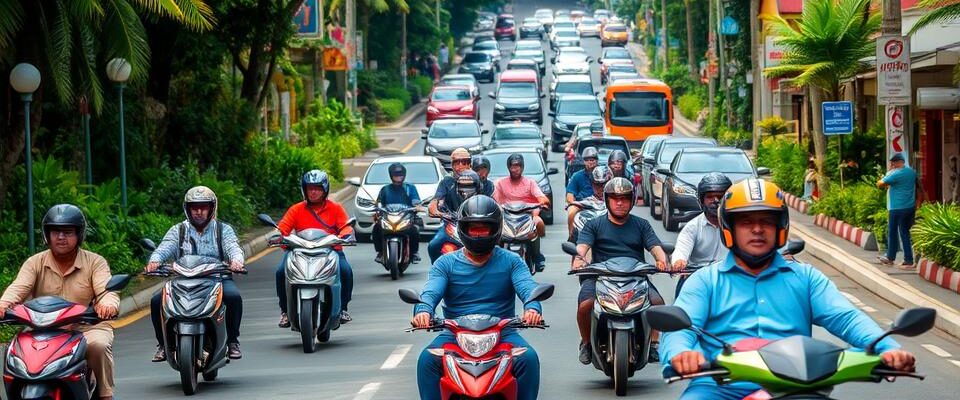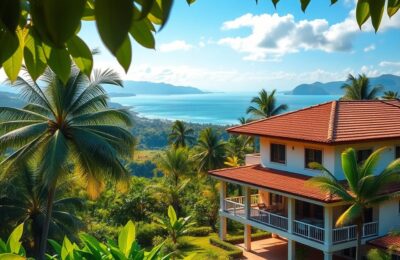Motorcycle Drivers in Costa Rica: Insights & Facts
What if the key to understanding Costa Rica’s vibrant lifestyle lies on two wheels rather than four? Motorcycle driving has become a big part of getting around in Costa Rica. It mixes daily trips with the excitement of seeing the country’s beautiful views.
As more people start riding motorcycles, they become a big part of the culture. This shows us how locals live and reminds us of the need for safety. With stats on motorcycle accidents in Costa Rica, we see why it’s so important to ride carefully. This article dives into the world of motorcycle riding in Costa Rica, sharing important insights and facts for everyone.
Key Takeaways
- Motorcycle driving is a popular mode of transport in Costa Rica.
- The legal driving age for motorcyclists is 18 years old.
- Approximately 1.5 million Costa Ricans live in San Jose, shaping the motorcycle culture.
- Defensive driving is crucial due to unpredictable road conditions.
- Common obstacles include animals and pedestrians on rural roads.
- Understanding traffic patterns is vital for safe riding during rush hours.
Understanding the Culture of Motorcycle Driving in Costa Rica
The motorcycle driver culture in Costa Rica is lively and varied. For many, bikes mean freedom and adventure. They let riders see the country’s beautiful landscapes. Dirt bikes are popular, showing the fun of exploring tough-to-reach places.
Riders in Costa Rica form strong bonds. They share stories and help each other, whether on the road or off. This community is built on respect, with riders looking out for one another.
The beauty of Costa Rica shapes the motorcyclists’ experiences. They enjoy riding through rainforests, along coasts, and up mountains. But, they also face challenges like dealing with traffic and following road laws.
Tourism has grown, bringing new people to the biking scene in Costa Rica. Visitors rent bikes to explore, adding to the local culture and enhancing their trips.
About the Motorcycle Drivers in Costa Rica
In Costa Rica, motorcycle riders come from all walks of life. They range in age, gender, and background. Many use motorcycles as their main way to get around, showing how important they are in the culture.
Young professionals love the freedom of riding two wheels. Older adults use them for ease and cost. This mix of ages shows how motorcycles fit into the culture.
The demographics of motorcyclists
About 60% of riders in Costa Rica are polite on the road. They care about safety and respect. But, 40% ride aggressively, causing problems.
Every week, a motorcycle crash happens in cities like San Jose. It’s often because cars don’t stop for bikes. Yet, fewer riders tailgate now, showing a change in driving habits.
Common motorbike brands among Costa Rican drivers
In Costa Rica, Honda, Yamaha, and Suzuki are top choices. Riders trust these brands for their toughness and performance. These brands are big in the local motorbike scene.
Knowing the motorbike laws in Costa Rica is key. These rules affect what bikes people can own and ride. They shape the riding experience for everyone.
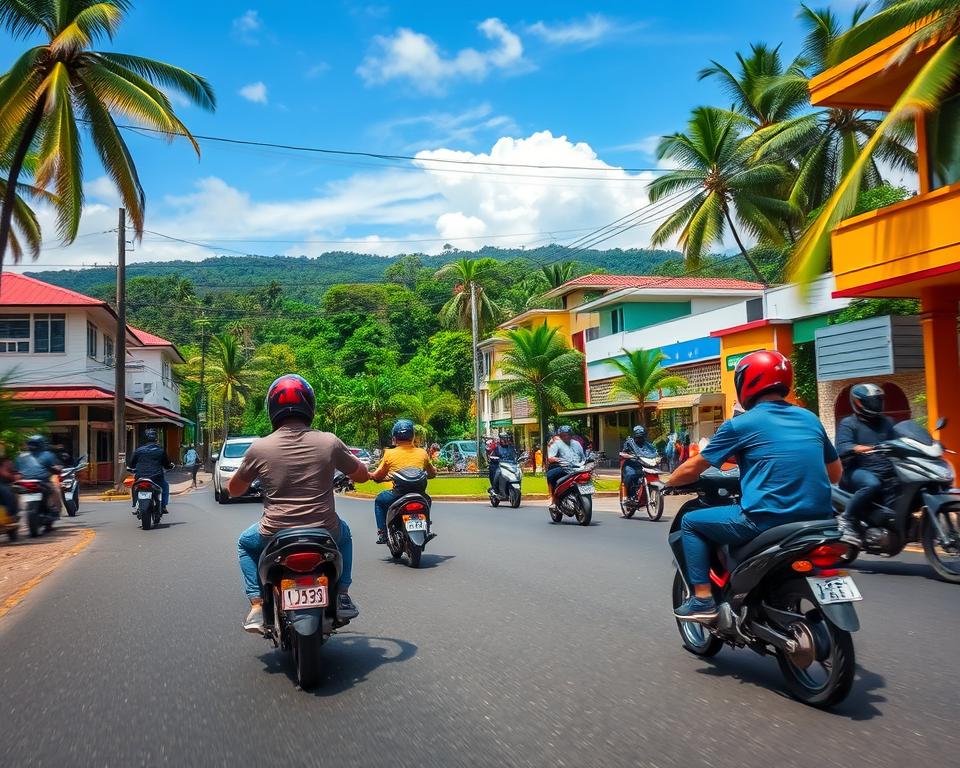
Legal Requirements for Motorcycle Operators
Knowing the laws for motorcycles makes the roads safer. Costa Rica has rules for both locals and visitors. These rules help riders enjoy the country’s motorcycle culture safely.
Obtaining a motorcycle driver’s license
To ride a motorcycle legally in Costa Rica, you need a license. You must pass a written and practical test. Foreigners can drive with a foreign license for up to 180 days.
If you want a Costa Rican license, you might not need more tests. This depends on your experience.
Insurance and registration necessities
Having the right insurance is crucial for safety. Riders must have a policy that covers liability and damages. Also, motorcycles need to be registered every year.
Annual inspections and regulations
Every year, motorcycles must go through safety checks. These checks ensure the bike is in good shape. Following these rules shows a rider’s commitment to safety.
Safety Considerations for Motorcycle Riders
Safety is key for motorcyclists in Costa Rica’s lively roads. Riders must wear protective gear and watch out for dangers to avoid accidents. Following important safety tips can make riding safer and more enjoyable.
Essential safety gear for motorcyclists
Wearing the right safety gear can greatly reduce injury risk in crashes. Important items include:
- Helmets: Protects the head, with attention to chin and face coverage as nearly half of helmet impacts occur in these areas.
- Gloves: Ensures grip and protects hands from abrasions.
- Long pants and jackets: Provide skin protection against scrapes and road rash.
- Sturdy boots: Protects feet and ankles during falls.
Common hazards on Costa Rican roads
Motorcyclists need to watch out for specific dangers on Costa Rica’s roads. Some major risks include:
- Potholes: Common on rural roads, they require careful navigation.
- Livestock: Animals crossing the road unexpectedly can pose significant risks.
- Aggressive driving behavior: Keep an eye out for reckless drivers, specially in urban areas like San Jose.
Motorcycle safety guidelines and defensive driving tips
Following safety guidelines is crucial to reduce risks. Riders should use defensive driving techniques, such as:
- Maintaining a safe following distance to allow for sudden stops.
- Staying aware of surroundings and anticipating potential hazards.
- Familiarizing themselves with local traffic regulations to avoid legal problems.
- Participating in advanced rider training programs to build confidence and enhance skills.
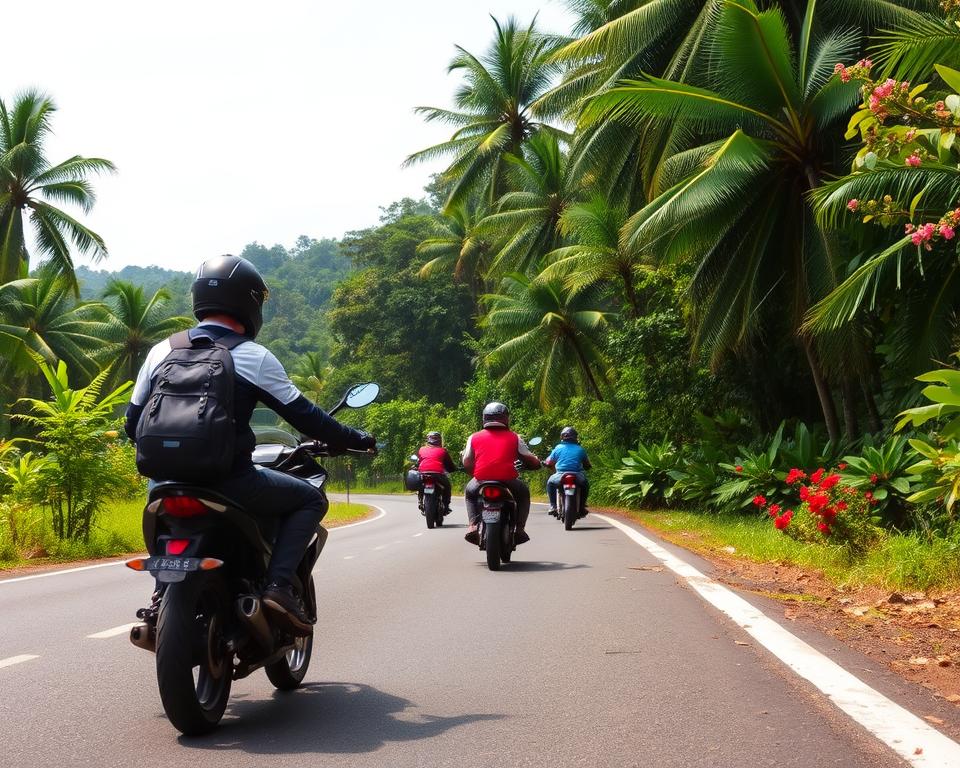
Exploring Costa Rica on Two Wheels
Adventure awaits those who choose to explore Costa Rica by motorcycle. This beautiful country offers a mix of culture, stunning landscapes, and friendly locals. Riders can enjoy various routes, from motorcycles to ATVs, making every journey captivating.
Popular motorcycle routes in Costa Rica
The Interamericana Highway is a top route, passing through scenic valleys and lively towns. Coastal roads along the Pacific Ocean offer breathtaking views. Other favorites include the ride to Arenal Volcano and the roads of Monteverde, both part of costa rica motorcycle tours.
Scenic destinations for motorcyclists
Motorcyclists are drawn to scenic spots like Arenal Volcano and Manuel Antonio National Park. Arenal offers hiking and zip-lining in lush rainforest. Manuel Antonio has stunning beaches and wildlife, making it a must-see for riders.
The best time of year for motorcycle travel
Choosing the right time is key for a motorcycle trip in Costa Rica. The dry season, from December to April, is best for riding. The roads are safer and more enjoyable during this time. Always check the weather forecast to plan your trip.
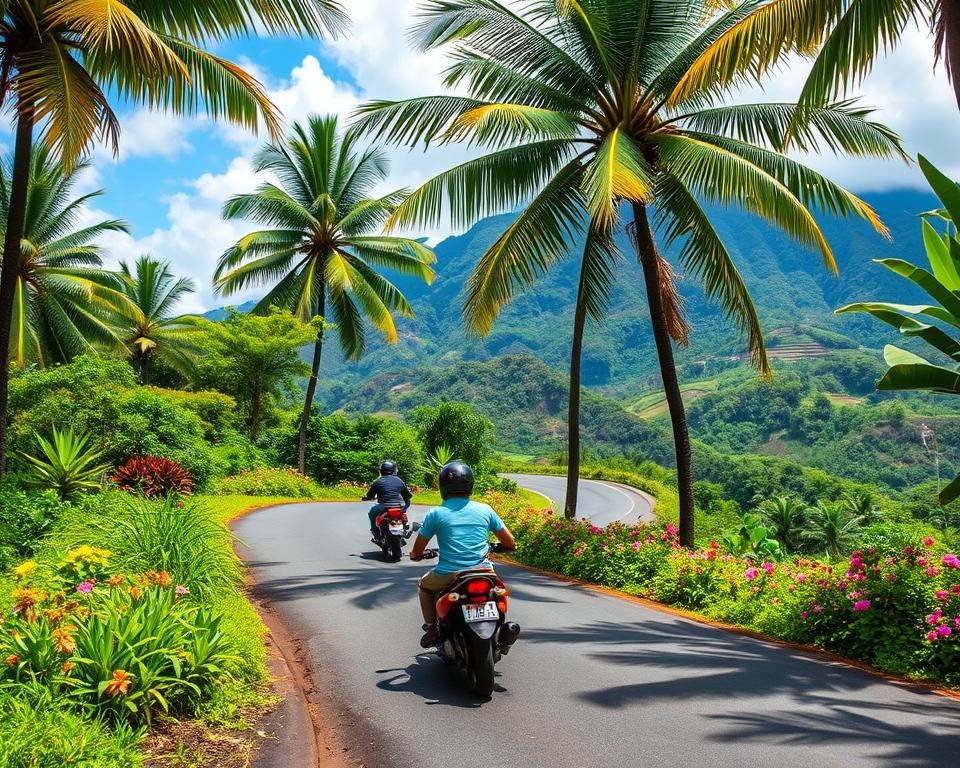
For a better adventure, consider different travel options. Costa Rica has many amenities, and costa rica motorcycle tours offer professional guidance. Riding through this stunning country is an experience you won’t forget.
Motorcycle Community in Costa Rica
The motorcycle community in Costa Rica is lively and varied. It brings together riders from different backgrounds. Local clubs and larger associations unite people through their love for biking.
These groups create a sense of friendship. They also focus on safety and responsible riding. This helps the biking community in Costa Rica grow stronger.
Clubs and associations among riders
Motorcyclist associations in Costa Rica are key in planning events. They host charity rides and weekend trips. This lets riders see the country’s beauty together.
Clubs like the Costa Rica Motorcycle Club support their members. They organize group rides, social events, and share resources. This helps build the biker lifestyle in Costa Rica.
Social events and group rides
Social events are the heart of the motorcycle community in Costa Rica. Regular rides help riders bond over their love for motorcycling. They also have charity events to help local causes.
These events show the community’s commitment to giving back. They strengthen the sense of belonging among members. They also encourage safe riding practices.
Online forums for motorbike enthusiasts
Digital platforms have made it easier for riders to connect. Online forums let them share experiences and advice. They discuss maintenance tips and upcoming rides.
Riders can find information and connect with others. This strengthens the unity in the biking culture. For more on living in Costa Rica, visit Grupo Gap LLC SRL, a real estate service.
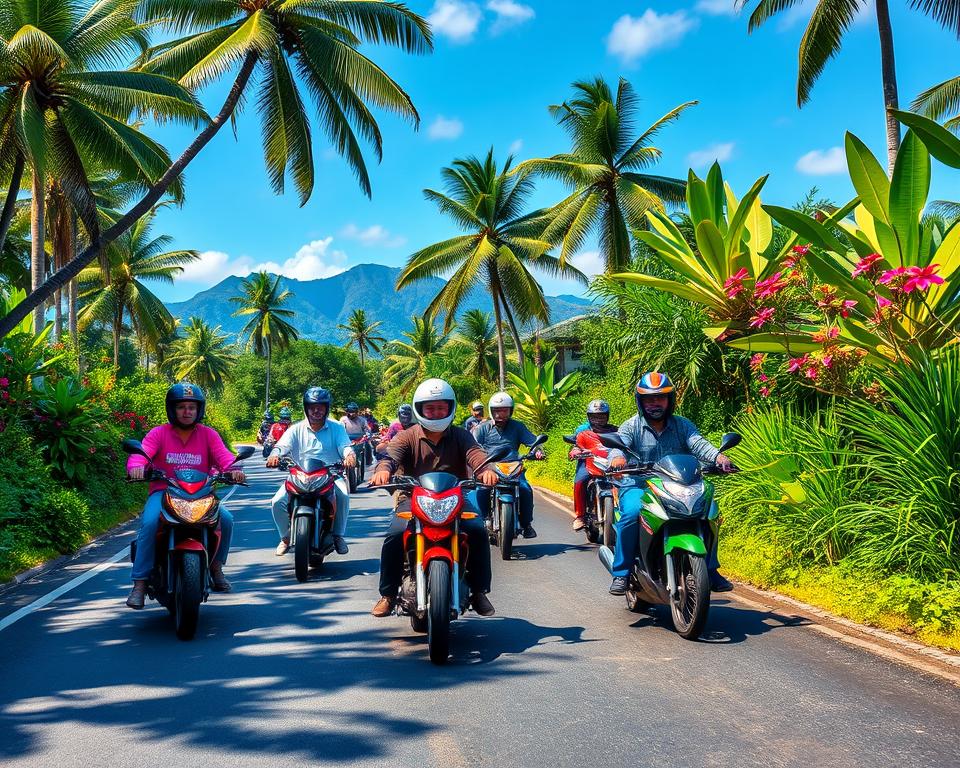
Mounted Traffic Challenges in Costa Rica
Riding motorcycles in Costa Rica can be tough due to traffic. Urban areas have complex traffic patterns. It’s key to know these for the motorcycle culture in Costa Rica.
Understanding the traffic patterns in urban areas
San Jose’s traffic is chaotic. Drivers are often impatient, and roads are not well-made. Riders face police checkpoints many times a year.
These checkpoints can slow you down, making trips longer. For example, a trip from San Jose to Playa Flamingo can take four hours.
Riding conditions in rural and coastal regions
Rural and coastal areas have different riding conditions. Roads are often in bad shape. You have to watch out for animals and people.
Riding in Costa Rica is exciting but comes with challenges. Being aware and prepared is important. For more on property transactions, check out this guide on open listings.
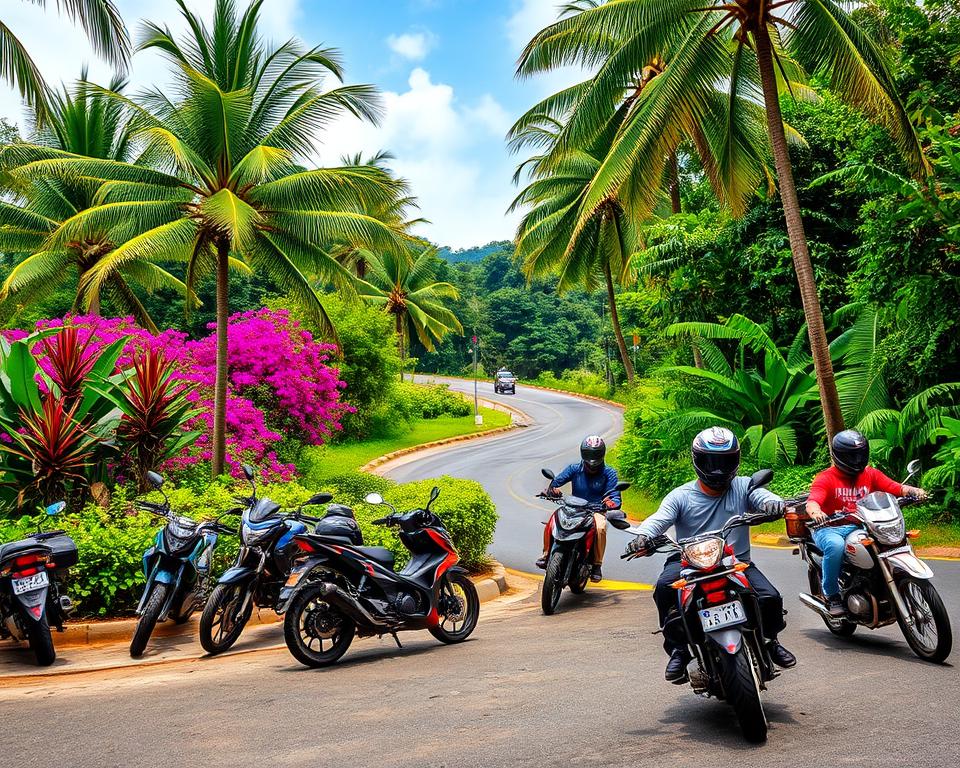
Renting vs. Purchasing Motorcycles in Costa Rica
Choosing between renting or buying a motorcycle in Costa Rica can greatly affect your trip. Each option has its own set of benefits and challenges. It’s important to know the differences to make the right choice.
Overview of motorcycle rental options
Renting motorcycles gives tourists the freedom to explore without a big commitment. Renters must be at least 21 and often need basic insurance. Prices vary based on the bike and how long you rent it:
- Honda Navi-110 scooter: $10 per hour, $40 for a full day.
- Honda CRF250F motorcycle: $20 per hour, $80 for a full day.
- ATV costs range from $60 per hour to $840 for a week.
Rental companies charge an extra 12% if you rent from the airport. Basic insurance is usually included but only covers damage to others’ vehicles, not the rental bike.
Benefits of owning a motorcycle in Costa Rica
Buying a motorcycle offers long-term benefits, like personal comfort and convenience. It also means you can travel at your own pace. Plus, you can customize your bike and save money in the long run.
For motorcycle lovers, joining the local riding culture is rewarding. You can attend community events and explore off-the-beaten paths more easily with your own bike.
Financial considerations for travelers
Renting motorcycles is often cheaper for short trips. Daily fees and insurance add up but are still affordable for short stays. Buying a motorcycle, on the other hand, means ongoing costs like maintenance and insurance. These can be a big expense.
It’s also important to follow Costa Rica’s road speed limits. These range from 60 km/h on secondary roads to 120 km/h on highways. Following these laws helps avoid fines and keeps you safe.
Conclusion
The world of motorcycle driving in Costa Rica is as varied as its beautiful landscapes. Riders here love adventure and care about their community. This makes it welcoming for both new and experienced riders.
When riding through Costa Rica’s streets and scenic paths, it’s clear that bikes are more than just a way to get around. They open doors to the area’s rich culture and history.
It’s important for everyone to ride safely and follow the law. Knowing how to handle different terrains and weather is key. Being aware of Costa Rica’s unique riding dangers helps make the journey better.
Exploring Costa Rica on a motorcycle can lead to unforgettable moments. Riders get to see amazing views and meet new people. By focusing on safety and being mindful, everyone can enjoy the beauty of Costa Rica’s roads.
Source Links
- https://mytanfeet.com/about-cr/tips-for-driving-in-costa-rica/
- https://www.twoweeksincostarica.com/buying-a-car-in-costa-rica/
- https://www.godutchrealty.blog/driving-in-costa-rica/
- https://daysafar.co/podcast/e24
- https://osatropicalproperties.com/blog/driving-in-costa-rica-with-a-foreign-license-a-guide-for-expats-new-180-day-visa-update
- https://costaricaresidencycard.com/2024/01/05/driving-in-costa-rica/
- https://crie.cr/do-you-need-a-license-to-ride-a-motorcycle-in-costa-rica/
- https://crie.cr/are-motorcycle-drivers-safe-in-costa-rica/
- https://motogsworldtours.com/moto-blog/motorcycling/traffic-regulations-in-south-america-peru
- https://crie.cr/topics-of-interest/
- https://riiroo.com/blogs/ride-on-toy-guides/motorcycle-safety-a-beginners-guide?srsltid=AfmBOoprnpY2njC2OSDUPZHUgazs2z6gIhhN5_mbRsVp8cq0LLPUCAYe
- https://costaricatravelblog.com/costa-rica-transportation/
- https://atvalerioscostarica.com/rentals/
- https://www.marriott.com/en-us/hotels/lirwh-w-costa-rica-reserva-conchal/overview/
- https://ticotimes.net/2024/08/31/driving-in-costa-rica-the-perils-and-peculiarities-on-the-road
- https://birdingcraft.com/wordpress/2024/08/17/birding-trip-to-costa-rica-driving-dos-and-donts/
- https://www.bluezonelegal.com/immigration-news/new-costa-rica-expat-driving-legislation/
- https://www.goingpuravida.com/driving-in-costa-rica.html
- https://axrjaco.com/guide-to-motorcycle-rental-and-traveling-in-costa-rica/
- https://axrjaco.com/vehicle-rentals/
- https://vietnammotorbiketoursclub.com/vietnam-motorcycle-adventure.htm
- https://www.puravidatraveling.com/post/how-to-get-to-montezuma-or-tambor-from-liberia-or-lir-airport-costa-rica

